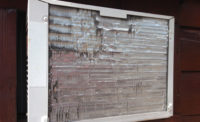Refrigerant blends are mixtures of refrigerants. These blends have been carefully formulated and mathematically modeled to tailor their characteristics to match certain properties of the refrigerants they are replacing and to provide maximum system efficiency and performance.
In the past, refrigerant blends have been based on chlorofluorocarbon (CFC), hydrochlorofluorocarbon (HCFC), and hydrofluorocarbon (HFC) refrigerants. However, because of ozone depletion potential (ODP) and global warming potential (GWP) regulations, most of today’s refrigerant blends are HFC-based and have zero ODP with small GWP impacts to the environment.
Even though most of today’s blends are HFC-based, they can sometimes contain a small percentage of a hydrocarbon (HC) as a refrigerant. The HC, however, will not make the blend flammable because it only constitutes a small percentage (usually less than 3 percent) of the total refrigerant blend. Some of the HCs are used for purposes other than a refrigerant. For example, the HC propane (R-290) is also used as a fuel for heating. However, different purity levels are required for each application. Fuel-grade propane (LPG) is never used as a refrigerant. The quality of fuel-grade propane’s composition varies substantially and can include a high level of moisture and unsaturated hydrocarbons. Only refrigerant-grade propane can be used as a refrigerant. Also, fuel-grade propane contains a stenching agent (methyl mercaptan) that gives it a “rotten egg” smell so it can be easily detected by humans. Methyl mercaptan will introduce unwanted byproducts if used as a refrigerant in a refrigeration or air conditioning system and can cause corrosion.
A QUICK REVIEW
Refrigerant blends are made up of two or more single-component refrigerants. Refrigerant blends can have two, three, four, five, or more refrigerants making up the composition of the blend. For example:
• R-410A consists of two refrigerants: R-32 and -125;
• R-404A consists of three refrigerants: R-125, -143a, and -134a;
• R-427A consists of four refrigerants: R-32, -125, -143a, and -134a; and
• R-438A consists of five refrigerants: R-32, -125, -134a, -600, and -601a.
Single-component refrigerants, such as R-22, -32, -123, -125, -134a, -143a, -290 (propane), -600 (isobutane), and -601a (isopentane), to name a few, have only one molecule in their structures so they evaporate and condense at one constant temperature for a given pressure. This means their saturated liquid and saturated vapor temperatures are the same for one given pressure. In both the evaporator and the condenser, both liquid and vapor exist in equilibrium. As a result, the temperature glide of a single-component refrigerant is zero. Zeotropic refrigerant blends behave like a mixture of the individual components. Their liquid and vapor composition is different at most given temperatures and pressures. They exhibit temperature glide and are represented by the 400-series blends. Examples of these are R-401A, -407C, -409A, and -438A, to name a few.
Azeotropic refrigerant blends behave like single-component refrigerants. The composition of the vapor phase and liquid phase is the same for azeotropic refrigerant mixtures at their azeotropic temperatures and pressures. When these blends are mixed in precise proportions, they act like a compound that has a boiling temperature independent of the boiling temperature of the individual liquids. They do not exhibit any noticeable temperature glide. These blends are represented by the 500-series blends. Some examples are R-500, -502, and -507.
Near-azeotropic refrigerant blends act similarly to an azeotropic blend; however, these blends exhibit a small but noticeable amount of temperature glide when they phase change. These blends have predictable blend properties, but the difference between these properties and what is observed for single-component refrigerants is not very significant. Examples of these blends are R-410A, -404A, and many other refrigerant blends.
ANALYZING THE COMPONENTS OF A BLEND
As mentioned earlier, a number of single-component refrigerants make up the composition of a refrigerant blend. Let’s look at an example refrigerant blend — R-438A — and see what each component brings to the party.
R-438A is an R-22 retrofit refrigerant blend consisting of R-32, -125, -134a, -600, and -601a. The weight percentages of the five components are 8.5, 45, 44.2, 1.7, and 0.6 percent, respectively. R-438A typically yields 5-10 percent lower capacities and similar energy efficiency ratios (EERs) when compared to R-22. R-438A has similar pressure/enthalpy characteristics compared to R-22 in low- and medium-temperature refrigeration systems and air conditioning applications. It’s compatible with mineral oil (MO), alkylbenzene (AB), and polyolester (POE) lubricants.
• The R-600 and -601a component of -438A — R-600 is the HC butane, and R-601a is the HC isopentane. These two HCs constitute a very small percentage of the total R-438A blend. This small amount of HCs helps thin the mineral oil so it has a lower viscosity, enhancing the oil’s return to the compressor’s crankcase. This characteristic was intentionally designed into the blend to achieve mineral oil compatibility, which many other retrofit blends lack. If used alone as single-component refrigerants, both R-600 and -601a are highly flammable. However, because of the small percentages of these two HCs, R-438A is not flammable. Its ASHRAE safety group classification is A1, meaning it has no flame propagation and is very low in toxicity (see Figure 1). R-600 and -601a are very low in toxicity and have very low GWP values.
• The R-32 component of R-438A — HFC-32 (R-32), as a single-component refrigerant, falls into the A2 safety group classification, meaning it is very low in toxicity and has low-flammability characteristics. However, when 8.5 percent of R-32 is used as one of the five-part mixtures in R-438A, the blend is not flammable and falls into the A1 safety group classification. Another refrigerant blend, R-410A, consists of a 50 percent mix of R-32 and -125. The refrigerant blend R-407C contains 23 percent of R-32 in its mixture, along with 25 percent of R-125 and 52 percent of R-134a. Many refrigerant blends have R-32 as a component in their blends.
R-32 has high operating pressures; in fact its pressures are slightly higher than R-410A. This means it cannot be used as a drop-in replacement for existing systems. Also, as with R-410A, recovery cylinders, compressor shells, refrigerant cylinders, accumulators, receivers, and filter driers must be specifically engineered for R-32.
R-32 is very efficient in transferring heat and can reduce electrical consumption up to 10 percent compared to R-22 in air conditioning systems. R-32 has a potential refrigerating effect 1.5 times that of R-410A, while the pressure losses are lower for the same capacity. The liquid density of R-32 is 10 percent lower than -410A, meaning pipe diameters can be smaller. Smaller liquid densities also means that the system refrigerant charge could be up to 30 percent less than that of R-410A. R-32 has a very low environmental impact with a GWP of 675 and a zero ODP. Figure 2 shows the GWP values for a number of refrigerants.
The use of R-22 and R-410A presents a major global-warming risk should their use continue until 2020. In Japan and Australia, R-32 as a single-component refrigerant has become the major refrigerant replacing R-22 and -410A for air conditioning applications. Also, the developing markets of China, Brazil, and India have developed a demand for packaged air conditioning that is dwarfing that of the developed markets, and in those countries, R-32 is rapidly growing as a single-component refrigerant for air conditioning applications. This is all happening because its low-GWP and zero-ODP benefits, compared to other HFC refrigerants, outweigh its flammability properties when used as a single-component refrigerant for air conditioning applications.
• The R-134a component of R-438A — R-134a was the refrigerant of choice to replace R-12 in many medium- and high-temperature stationary refrigeration and air conditioning applications. In the past, it’s replaced R-12 in automotive air conditioning. However, because of its high-GWP value of 1,430, other refrigerants, such as the hydrofluoroolefin (HFO) R-1234yf, have been replacing R-134a in automotive air conditioning because of their much-lower GWP values.
R-134a has a safety classification of A1, meaning it’s very low in toxicity and nonflammable. R-134a has very similar pressure-temperature relationships and capacities to R-12. Its pressures are very workable both at low and high temperature ranges. R-134a does not fall into a vacuum until about minus 15°F and runs very acceptable compression ratios and capacities.
• The R-125 component of R-438A — R-125 has been used as a replacement for CFCs and is an important component of blends, such as R-410A, -407C, and -404A. R-125 is also a good fire-suppression agent, replacing Halon 1301.
R-125’s safety classification is A1. It has a zero ODP with a relatively high GWP of 3,450. R-125 boils at minus 55° at atmospheric pressure, which gives it very acceptable pressures, compression ratios and makes it a great refrigerant that easily stays out of a vacuum.
MANY PARAMETERS TO CONSIDER
There are many interaction parameters chemical companies face when blending refrigerants to meet certain properties of the refrigerants they’re trying to replace. Much of this information, which is a science unto itself, is proprietary. Many times, depending if the blend is azeotropic or zeotropic when these blends are mixed in precise proportions, they act like compounds that have a boiling temperature independent of the boiling temperature of the individual liquids. Other qualities and properties of blends also may follow this phenomenon. Other properties (to mention a few) that affect performances of refrigerant blends are:
• Vapor densities;
• Liquid densities;
• Operating pressures;
• Compression ratios;
• Volumetric efficiencies;
• Coefficient of performances;
• Net refrigeration effects;
• Latent heat values;
• Heats of compression;
• Compressor discharge temperatures; and
• Overall efficiencies.
It’s very important to follow all safety procedures and retrofit guidelines when retrofitting a system with a refrigerant blend. By all means, never try to blend any refrigerants yourself because dangerous conditions and personal injury can occur.
Publication date: 12/7/2015
Want more HVAC industry news and information? Join The NEWS on Facebook, Twitter, and LinkedIn today!












